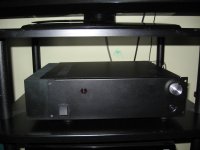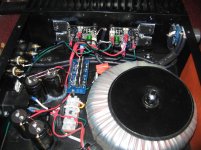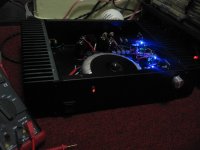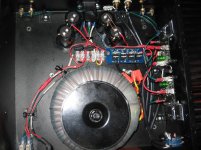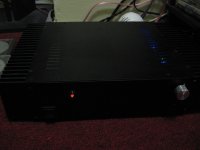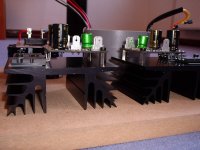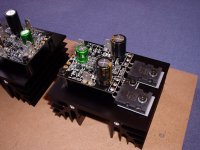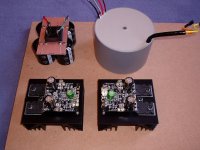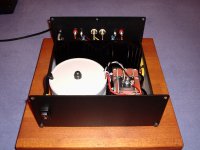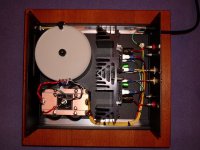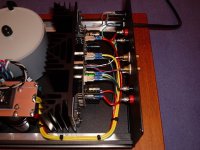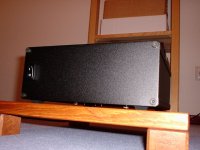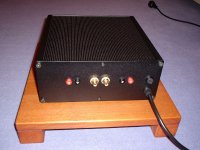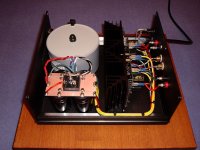small tanks!
Hello guys! I have some pictures of my new integrated amp from Aussie amplifiers,the HPA-nxv 200. I am still waiting for the input caps (sonicap 3.9uf).These kits are wonderful and the service from Anthony is top notch.These amps are really top quality all over and the sound is fantastic!!! I had it playing for a couple hours at really loud volume and the heat sink got just warm. I strongly recommend these kits.Thank you Anthony for great products and excellent service.
Hello guys! I have some pictures of my new integrated amp from Aussie amplifiers,the HPA-nxv 200. I am still waiting for the input caps (sonicap 3.9uf).These kits are wonderful and the service from Anthony is top notch.These amps are really top quality all over and the sound is fantastic!!! I had it playing for a couple hours at really loud volume and the heat sink got just warm. I strongly recommend these kits.Thank you Anthony for great products and excellent service.
Attachments
Case closed...
Attachments
Last edited:
Well, two things to mention:
- I did not use any input coupling caps, because my dac already has output coupling caps.
- As you can see from the transformer and the heatsinks, this is kind of a low power version. I use a transformer with 2x24V secondaries which gives around +/-34V rail voltage (around 50W per channel at 8 ohms).
- I did not use any input coupling caps, because my dac already has output coupling caps.
- As you can see from the transformer and the heatsinks, this is kind of a low power version. I use a transformer with 2x24V secondaries which gives around +/-34V rail voltage (around 50W per channel at 8 ohms).
Last edited:
Member
Joined 2002
Hi!
This is my take on Anthony's HPA-nxv200 amps.
First: The parts...
Do you like the sound?. I really like it, I have pushed it really hard and the sound is fantastic, I am using a 670vac 35x2 that gives me 48vdc per rail and I am using 20000uf per rail, I also noticed that the heat sink got just warm after having it playing loud for four hours, I am using it as integrated amp (using 10k potentiometer). The service from Anthony is wonderful.so far my tops amps and services are from Audiosector(Peter Daniel LM3875) and now Anthony (Aussie amplifiers HPA-nxv200). These are my two top. Right now I have the HPA-nxv200 playing in my living room and it will be there for a long time!.
By the way, your amp looks really neat,clean and professional made.
Last edited:
Do you like the sound?. I really like it, I have pushed it really hard and the sound is fantastic, I am using a 670vac 35x2 that gives me 48vdc per rail and I am using 20000uf per rail, I also noticed that the heat sink got just warm after having it playing loud for four hours, I am using it as integrated amp (using 10k potentiometer). The service from Anthony is wonderful.so far my tops amps and services are from Audiosector(Peter Daniel LM3875) and now Anthony (Aussie amplifiers HPA-nxv200). These are my two top. Right now I have the HPA-nxv200 playing in my living room and it will be there for a long time!.
By the way, your amp looks really neat,clean and professional made.
Hi lanchile!
I already noticed your HUGE tranformer! Nice one ;-)
Btw, I spoke to Anthony before I build mine and he told me that a higher supply rail voltage doesn't give better sonic results, that's why I build mine around this rather small 250VA transformer (Thel Audio) with a total of 40.000uF smoothing capacitance (Panasonic TS-HA). For my speakers the power is more than enough (simple 2-way, 90db sensitivity).
Well, yes, I do like the sound! I also build a LM3875 amp before, and I must say I seem to like the sound of discrete transistors better than the chip sound. Discrete designs to me simply do sound more, well, "real", if you know what I mean.
The nxv200 are really very well made amp modules, and Anthony did an excellent job here. Very well build, very reliable and stable.
I would say I find the sound to be just a tad more on the bright side than on the dark side of neutral. But this is a matter of personal preferences and system synergy. Perhaps I have do to some more work on my dac and/or my speakers...
(Or perhaps I listened far too long to a Naim power amp... ;-)
Or, here is another idea: This was the first time I used those Panasonic TS-HA caps in a power amp ps. Now I wonder if some BC Series 051/056 would have been a better choice?
But I think everything else about the nxv200 amps is top notch!
Regards!
Martin
Well, two things to mention:
- I did not use any input coupling caps, because my dac already has output coupling caps.
- As you can see from the transformer and the heatsinks, this is kind of a low power version. I use a transformer with 2x24V secondaries which gives around +/-34V rail voltage (around 50W per channel at 8 ohms).
placing the rectifier up there is not really a wise thing to go ....to my opinion you should locate the rectifier else were ( distance of the cables is not realy a problem ) and then feed your boards from the capacitor pcb and not the rectifier
regards sakis
Sakis,
look again.
The transformer feeds the rectifier~&~, the rectifier feeds the ends of the outer copper traces. The centre tap feeds the end of the zero volts trace.
The outputs come from the other ends of the traces with the 4 smoothing caps in between. Effectively the caps feed the power outputs.
I would twist each pair of secondary wires together and then join the zero volts above or to the securing bolt of the rectifier. Then twist the relative sets of +,-,g as triplets to each power amp. This massively reduces loop area and thereby emi fields.
look again.
The transformer feeds the rectifier~&~, the rectifier feeds the ends of the outer copper traces. The centre tap feeds the end of the zero volts trace.
The outputs come from the other ends of the traces with the 4 smoothing caps in between. Effectively the caps feed the power outputs.
I would twist each pair of secondary wires together and then join the zero volts above or to the securing bolt of the rectifier. Then twist the relative sets of +,-,g as triplets to each power amp. This massively reduces loop area and thereby emi fields.
placing the rectifier up there is not really a wise thing to go ....to my opinion you should locate the rectifier else were ( distance of the cables is not realy a problem ) and then feed your boards from the capacitor pcb and not the rectifier
regards sakis
Hi Sakis!
Actually the amp boards ARE fed from the cap pcb! If you have a closer look at the attached picture you can see the wires from the transformer going to the rectifier and the common ground on the left side of the pcb, and the wires from the rectifier (+ and -) are also going to the LEFT side of the pcb, while all wires to the amp boards are going off the pcb from the RIGHT side (I'm always referring to the attached pic). So, the amp boards aren't fed directly from the rectifier but from the pcb AFTER the caps.
I did that because I'm of the same oppinion as you are! Amp boards have to be fed from the caps, not from the rectifier.
Further more the rectifier is isolated from the common ground with a heat conductive pad. The placement is just a matter of limited space and shortest possible cable length.
Regards!
Martin
Attachments
Last edited:
the question is not were you get the power from i have seen that you take it from the caps ....my sugestion is regarding mostly the rectifier and having it working exactly on the top of your ground trace .... Ac and noises are too close to smoothing caps ...
Assuming that you take my advice and you relocate rectifier then you still need to get power from caps and not from the rectifier
regards sakis
Assuming that you take my advice and you relocate rectifier then you still need to get power from caps and not from the rectifier
regards sakis
the rectifier case is isolated from the diodes.Further more the rectifier is isolated from the common ground with a heat conductive pad.
You can connect the rectifier case direct to chassis or direct to the zero volts trace.
puting the rectifier too close to smoothing caps is bad practice is not question of isolation ..... having Ac cables too close to smoothing caps is also bad practice
Also messing up signal 0 volt with chassis ground is also bad practice at most cases, all professional amps of high levels of power feature ground lift switch not only to cancel ground loops issues but others also
Also messing up signal 0 volt with chassis ground is also bad practice at most cases, all professional amps of high levels of power feature ground lift switch not only to cancel ground loops issues but others also
the rectifier case is isolated from the diodes.
You can connect the rectifier case direct to chassis or direct to the zero volts trace.
Well, I know... ;-)
But I thought it might be a good idea to add a heat conducting pad, even though the diodes might not get warm at all. It's a 15A bridge.
Ok, bridge mounting also caught my attention, but being a picture thread I didnt comment
But now you are at it, bridge mount does look dangerous
If it gets loose and turns just a bit, the bridge housing could touch the neg/pos, and short the rails
Anyway, 15A bridge isnt that much really, I have always used 35A bridge
But now you are at it, bridge mount does look dangerous
If it gets loose and turns just a bit, the bridge housing could touch the neg/pos, and short the rails
Anyway, 15A bridge isnt that much really, I have always used 35A bridge
Hi lanchile!
I already noticed your HUGE tranformer! Nice one ;-)
Btw, I spoke to Anthony before I build mine and he told me that a higher supply rail voltage doesn't give better sonic results, that's why I build mine around this rather small 250VA transformer (Thel Audio) with a total of 40.000uF smoothing capacitance (Panasonic TS-HA). For my speakers the power is more than enough (simple 2-way, 90db sensitivity).
Well, yes, I do like the sound! I also build a LM3875 amp before, and I must say I seem to like the sound of discrete transistors better than the chip sound. Discrete designs to me simply do sound more, well, "real", if you know what I mean.
The nxv200 are really very well made amp modules, and Anthony did an excellent job here. Very well build, very reliable and stable.
I would say I find the sound to be just a tad more on the bright side than on the dark side of neutral. But this is a matter of personal preferences and system synergy. Perhaps I have do to some more work on my dac and/or my speakers...
(Or perhaps I listened far too long to a Naim power amp... ;-)
Or, here is another idea: This was the first time I used those Panasonic TS-HA caps in a power amp ps. Now I wonder if some BC Series 051/056 would have been a better choice?
But I think everything else about the nxv200 amps is top notch!
Regards!
Martin
I am using Mundorf caps 10000uf x4 and I like them very much. and I agree with you about LM3875/LM3886 I do not say these chips sound bad, They sound good but, compared to nxv200 there is no contest!. Anthony has build some of the best amp kits no doubt. 😉
- Home
- Amplifiers
- Solid State
- Post your Solid State pics here
